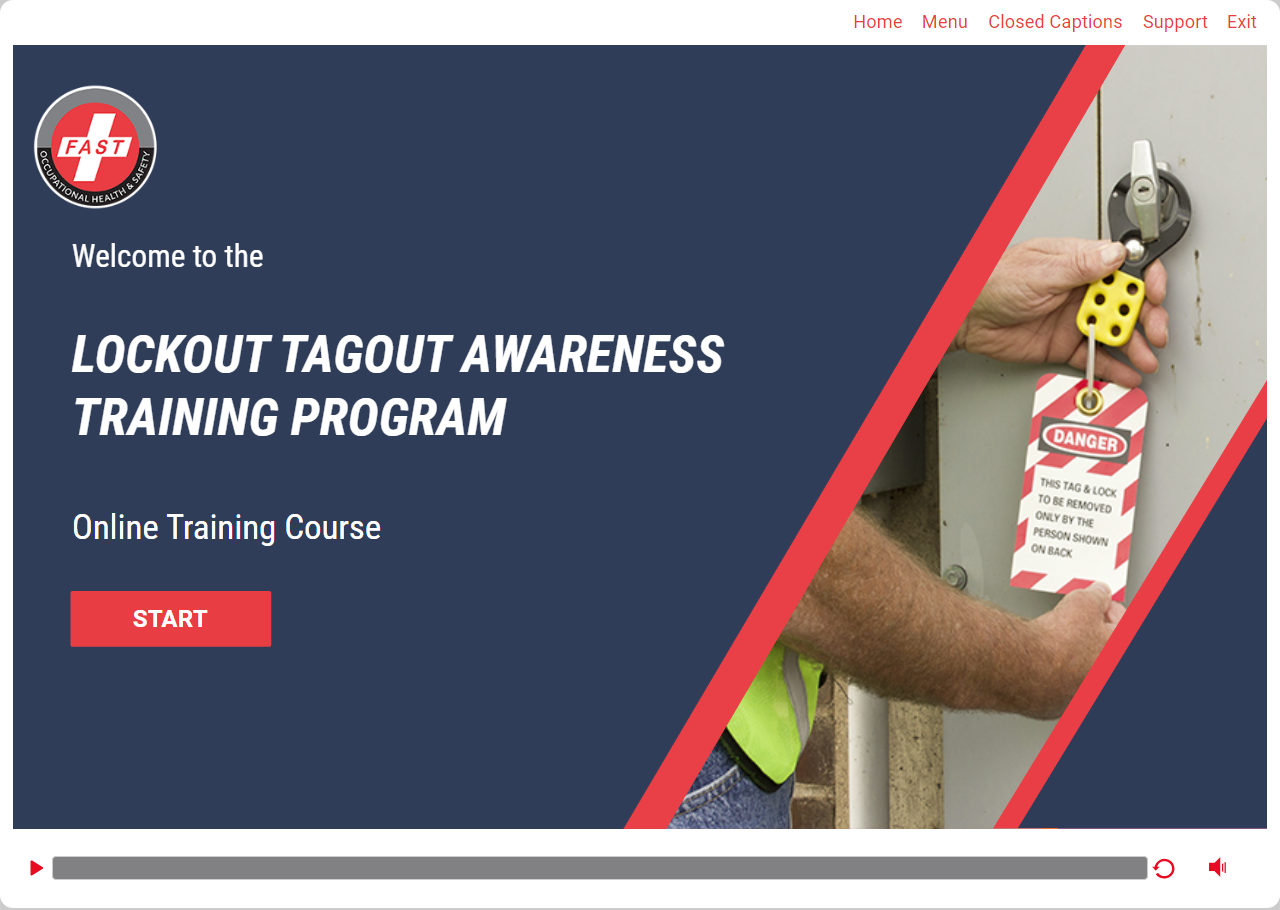
Lockout Tagout Awareness Training Program
(E-SLKT-E)
Introduction to Lockout Tagout Awareness Training Program
Occupational Health and Safety (OHS) – Lockout and Tagout Training Online Program
During LOTO training, employees learn about different types of hazardous energy sources that need to be locked out or tagged out, such as electrical, hydraulic, pneumatic, or mechanical energy.
They also learn how to identify and isolate these energy sources, how to properly lock and tag equipment, and how to verify that energy sources have been safely isolated before beginning work.
LOCKOUT AND TAGOUT TRAINING ONLINE COURSE OUTLINE
The course covers the following topics:
1. INTRODUCTION
This introductory chapter covers the servicing and maintenance of machines and equipment followed by relevant important details to provide learners’ an overview on Lockout and Tagout training program.
2. DEFINITIONS: LOCKOUT/TAGOUT
1. Authorized Employee: An authorized employee refers to an individual who has received formal training and official approval to perform energy control procedures.
2. Affected Employee: An affected employee is someone exposed to potential hazards during maintenance but not directly involved in lockout/tagout procedures.
3. Isolation: Isolation refers to the systematic and intentional disconnection or blocking of energy sources from a piece of equipment or machinery.
4. Energy-Isolating Device: An energy-isolating device is a physical mechanism that is used to completely shut off the energy supply to a piece of machinery or equipment.
5. Zero Energy State: Zero Energy State means all hazardous energy is completely isolated or dissipated from machinery, ensuring a safe work environment during maintenance.
3. DEFINITIONS: TYPES OF ENERGY
1. Mechanical: Mechanical refers to physical devices like valves or switches used to block energy flow and safely shut down machinery during maintenance.
2. Electrical: Electrical refers to energy-isolating devices specifically designed to control or cut off electrical power to machinery or equipment.
3. Hydraulic and Pneumatic: Hydraulic and Pneumatic refers to energy-isolating devices designed to control or block the flow of hydraulic fluids or compressed air to machinery or equipment.
4. Thermal and Chemical: Thermal and Chemical refers to energy-isolating devices designed to control or block the flow of heat or chemicals to machinery or equipment.
4. GENERAL LOCKOUT GUIDELINES
1. Electricity: Electricity is a form of energy resulting from the existence of charged particles (such as electrons or protons), either statically as an accumulation of charge or dynamically as a current.
Energy Source
General Lockout Guideline
2. Fluid Pressure: Fluid pressure refers to the force exerted by a liquid or gas on its surroundings. It’s the result of molecules in the fluid colliding with a surface or container.
Energy Source
General Lockout Guideline
3. Air Pressure: Air pressure is the force exerted by the weight of the air in the Earth’s atmosphere. It’s the push that the air exerts on everything it surrounds.
Energy Source
General Lockout Guideline
4. Kinetic Energy: Kinetic energy is the energy that an object possesses due to its motion. Simply put, when something is moving, it has kinetic energy.
Energy Source
General Lockout Guideline
5. Potential Energy: Potential energy is the stored energy that an object possesses due to its position or condition.
Energy Source
General Lockout Guideline
6. Pressurized Liquid and Gases: Pressurized liquids and gases refer to fluids (liquids or gases) that are subjected to an increased pressure, meaning they are compressed or forced into a confined space.
Energy Source
General Lockout Guideline
This is not all! The course offers a detailed look at each and every definition of lockout, tagout, or type of energy.
5. SCOPE AND APPLICATION
The scope and application of a lockout/tagout (LOTO) training program covers the OSHA standard for the Control of Hazardous Energy (Lockout/Tagout) 29 CFR 1910.147, which outlines the requirements for controlling hazardous energy sources during servicing and maintenance activities.
The purpose of the LOTO standard is to protect employees from hazardous energy sources, including electrical, mechanical, hydraulic, pneumatic, chemical, and thermal energy.
In scope and application, learn the following:
1. Covered Activities
2. Lockout/Tagout Rules
6. TYPES OF DEVICES
Lockout devices include a range of locks and other devices that can be used to control energy hazards.
1. Personal locks
2. Chains, Slings and Cables
3. Insulated Fuse Pullers
4. Blanks or Caps
5. Blocks or Pins
7. WRITTEN PROCEDURES
Lockout/tagout written procedures include:
1. Preparation for shutdown
2. Shutting down the equipment
3. Equipment isolation
4. Application of lockout/tagout devices
5. Release of stored energy
6. Verifying equipment isolation
8. SEQUENCE OF EVENTS
Learn about different sequences of events for lockout/tagout that have been mentioned in this chapter briefly.
9. LOCKOUT/TAGOUT INTERRUPTION
Lockout/Tagout interruption refers to a safety procedure used in workplaces, especially in industries with machinery and equipment. The chapter describes the steps to be followed when there is a need to test or position a machine that has been locked or tagged for safety reasons.
It suggests that before proceeding with the test, the equipment or process should be cleared of any tools and materials and workers should be kept at a safe distance.
The locks and tags should then be removed as per the established procedure, and the test should be carried out. After the test is complete, all systems should be de-energized and the controls should be re-locked or re-tagged before work is resumed.
The purpose of these steps is to ensure that the safety of workers and equipment is maintained during the testing or positioning process.
10. MULTI-LOCK LOCKOUT
Multi-lock lockout refers to a safety practice where multiple locks are used to secure a piece of equipment during maintenance or servicing. The chapter outlines the procedure for using a multi-lock device when more than one person needs to work on equipment.
According to the procedure, a multi-lock device should be attached at the main disconnect, and each person working on the equipment must ensure that it is de-energized while they are working on it.
Each worker should then attach their lock to the multi-lock device. The use of a multi-lock device is mandatory when a lock transfer is necessary.
The purpose of these steps is to ensure that every person working on the equipment is aware of the status of the lockout and that no one can inadvertently remove someone else’s lock, which could result in injury or damage to equipment.
11. RESTORING EQUIPMENT TO SERVICE
Restoring equipment to service refers to the process of bringing machinery or equipment back into operation after it has undergone maintenance, servicing, or repairs. In this chapter, learn the steps for restoring equipment to service along with appropriate images to give learners’ a clarity about it.
12. LOCKOUT/TAGOUT DEVICES
Lockout/Tagout devices are tools and mechanisms used in workplace safety procedures to control the energy sources of machinery and equipment during maintenance, servicing, or repair.
1. Durable
2. Standardized
3. Substantial
4. Identifiable
13. PERIODIC INSPECTIONS/OBSERVATIONS
Periodic inspections/observations refer to scheduled and regular assessments or examinations conducted at intervals over time. The chapter describes that it is important to conduct inspections or observations on a regular basis, at least once a year, to ensure that energy control procedures are being followed correctly and that employees are aware of their responsibilities.
The purpose of these inspections is to verify that the procedures in place for controlling energy sources, such as electricity, gas, or steam, are still effective and that employees are adhering to them.
By performing these regular checks, organizations can identify any deficiencies or weaknesses in their energy control procedures and take corrective actions to mitigate potential hazards and prevent accidents or injuries.
- Lockout Tagout Awareness Training Program
- Download Certificate
Student Reviews
Feedback from students who have taken this course.

